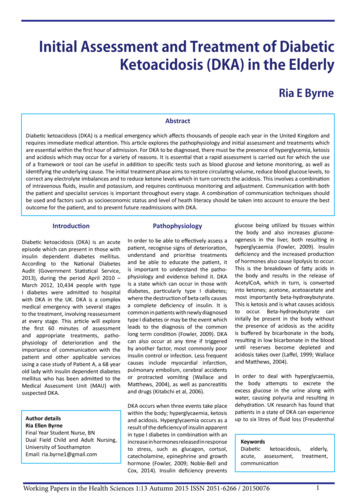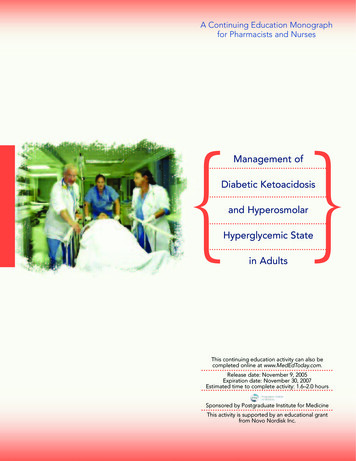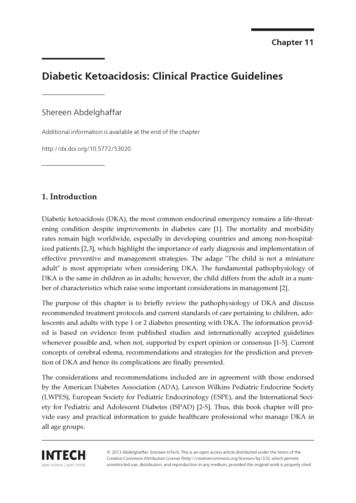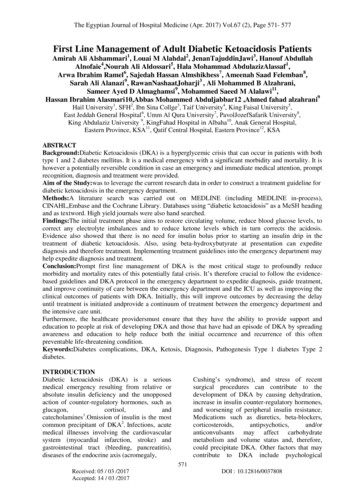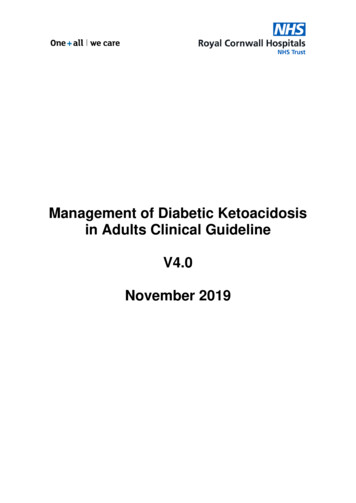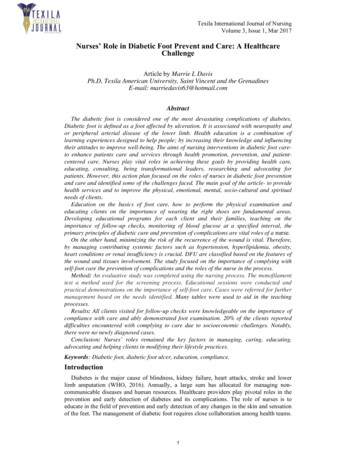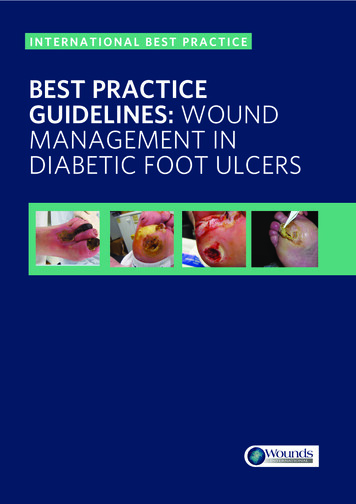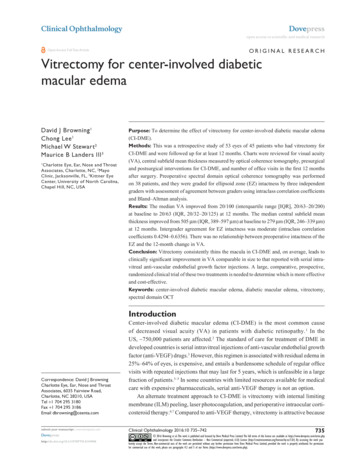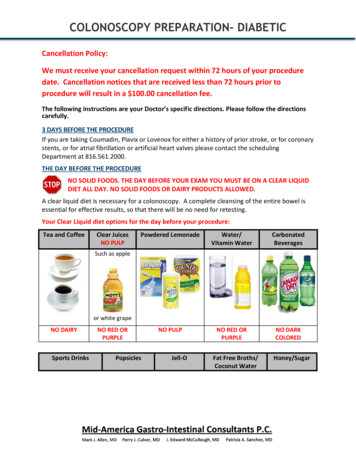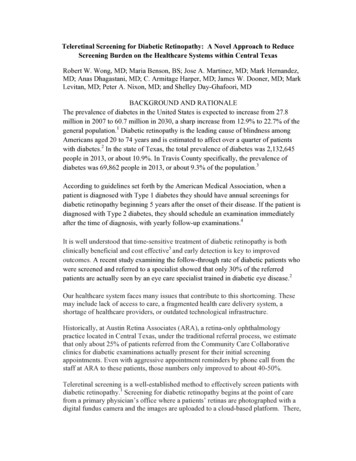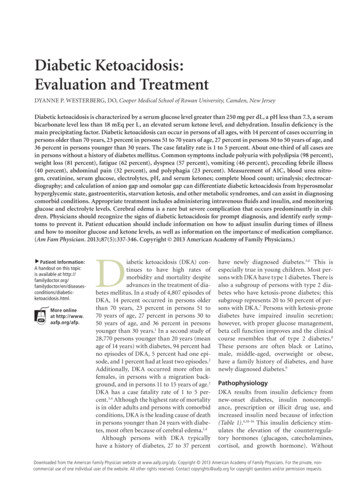
Transcription
Diabetic Ketoacidosis:Evaluation and TreatmentDYANNE P. WESTERBERG, DO, Cooper Medical School of Rowan University, Camden, New JerseyDiabetic ketoacidosis is characterized by a serum glucose level greater than 250 mg per dL, a pH less than 7.3, a serumbicarbonate level less than 18 mEq per L, an elevated serum ketone level, and dehydration. Insulin deficiency is themain precipitating factor. Diabetic ketoacidosis can occur in persons of all ages, with 14 percent of cases occurring inpersons older than 70 years, 23 percent in persons 51 to 70 years of age, 27 percent in persons 30 to 50 years of age, and36 percent in persons younger than 30 years. The case fatality rate is 1 to 5 percent. About one-third of all cases arein persons without a history of diabetes mellitus. Common symptoms include polyuria with polydipsia (98 percent),weight loss (81 percent), fatigue (62 percent), dyspnea (57 percent), vomiting (46 percent), preceding febrile illness(40 percent), abdominal pain (32 percent), and polyphagia (23 percent). Measurement of A1C, blood urea nitrogen, creatinine, serum glucose, electrolytes, pH, and serum ketones; complete blood count; urinalysis; electrocardiography; and calculation of anion gap and osmolar gap can differentiate diabetic ketoacidosis from hyperosmolarhyperglycemic state, gastroenteritis, starvation ketosis, and other metabolic syndromes, and can assist in diagnosingcomorbid conditions. Appropriate treatment includes administering intravenous fluids and insulin, and monitoringglucose and electrolyte levels. Cerebral edema is a rare but severe complication that occurs predominantly in children. Physicians should recognize the signs of diabetic ketoacidosis for prompt diagnosis, and identify early symptoms to prevent it. Patient education should include information on how to adjust insulin during times of illnessand how to monitor glucose and ketone levels, as well as information on the importance of medication compliance.(Am Fam Physician. 2013;87(5):337-346. Copyright 2013 American Academy of Family Physicians.) Patient Information:A handout on this topicis available at nditions/diabeticketoacidosis.html.More onlineat http://www.aafp.org/afp.Diabetic ketoacidosis (DKA) con tinues to have high rates ofmorbidity and mortality despiteadvances in the treatment of dia betes mellitus. In a study of 4,807 episodes ofDKA, 14 percent occurred in persons olderthan 70 years, 23 percent in persons 51 to70 years of age, 27 percent in persons 30 to50 years of age, and 36 percent in personsyounger than 30 years.1 In a second study of28,770 persons younger than 20 years (meanage of 14 years) with diabetes, 94 percent hadno episodes of DKA, 5 percent had one epi sode, and 1 percent had at least two episodes.2Additionally, DKA occurred more often infemales, in persons with a migration back ground, and in persons 11 to 15 years of age.2DKA has a case fatality rate of 1 to 5 per cent.3,4 Although the highest rate of mortalityis in older adults and persons with comorbidconditions, DKA is the leading cause of deathin persons younger than 24 years with diabe tes, most often because of cerebral edema.1,4Although persons with DKA typicallyhave a history of diabetes, 27 to 37 percenthave newly diagnosed diabetes.5,6 This isespecially true in young children. Most per sons with DKA have type 1 diabetes. There isalso a subgroup of persons with type 2 dia betes who have ketosis-prone diabetes; thissubgroup represents 20 to 50 percent of per sons with DKA.7 Persons with ketosis-pronediabetes have impaired insulin secretion;however, with proper glucose management,beta cell function improves and the clinicalcourse resembles that of type 2 diabetes.8These persons are often black or Latino,male, middle-aged, overweight or obese,have a family history of diabetes, and havenewly diagnosed diabetes.9PathophysiologyDKA results from insulin deficiency fromnew-onset diabetes, insulin noncompli ance, prescription or illicit drug use, andincreased insulin need because of infection(Table 1).4,10-16 This insulin deficiency stim ulates the elevation of the counterregula tory hormones (glucagon, catecholamines,cortisol, and growth hormone). WithoutMarch 1, 2013Volume87,FamilyNumber5 website at www.aafp.org/afp.www.aafp.org/afp American Academy of FamilyAmericanDownloadedfrom theAmericanPhysicianCopyright 2013Physicians.FamilyFor the Physicianprivate, non- 337commercial use of one individual user of the website. All other rights reserved. Contact copyrights@aafp.org for copyright questions and/or permission requests.
Diabetic KetoacidosisSORT: KEY RECOMMENDATIONS FOR PRACTICEEvidenceratingReferencesVenous pH may be measured as an alternativeto arterial pH in persons with DKA whoare hemodynamically stable and withoutrespiratory failure.C19Serum ketone level should be used in thediagnosis and management of DKA.C22Subcutaneous insulin can be used for treatmentof uncomplicated DKA.C29, 32Bicarbonate therapy has not been shown toimprove outcomes in persons with DKA, butis recommended by consensus guidelines forpersons with a pH less than 6.9.C33, 34Clinical recommendationthe ability to use glucose, the body needsalternative energy sources. Lipase activityincreases, causing a breakdown of adiposetissue that yields free fatty acids. These com ponents are converted to acetyl coenzyme A,some of which enter the Krebs cycle forenergy production; the remainder are bro ken down into ketones (acetone, acetoac etate, and β-hydroxybutyrate). Ketones canbe used for energy, but accumulate rapidly.Glycogen and proteins are catabolized toform glucose. Together, these factors pro mote hyperglycemia, which leads to anosmotic diuresis resulting in dehydration,metabolic acidosis, and a hyperosmolar state(eFigure A).DKA diabetic ketoacidosis.A consistent, good-quality patient-oriented evidence; B inconsistent or limitedquality patient-oriented evidence; C consensus, disease-oriented evidence, usualpractice, expert opinion, or case series. For information about the SORT evidencerating system, go to http://www.aafp.org/afpsort.xml.DiagnosisTYPICAL CLINICAL PRESENTATIONThe presentation of DKA varies with severity and comor bid conditions. Polyuria with polydipsia is the most com mon presenting symptom and was found in 98 percent ofpersons in one study of childhood type 1 diabetes. Othercommon symptoms included weight loss (81 percent),fatigue (62 percent), dyspnea (57 percent), vomiting (46percent), preceding febrile illness (40 percent), abdomi nal pain (32 percent), and polyphagia (23 percent).17Dehydration causes tachycardia, poor skin turgor, drymucous membranes, and orthostatic hypotension. Themetabolic acidosis may lead to compensatory deep (Kuss maul) respirations, whereas increased acetone can besensed as a fruity smell on the patient’s breath. Mentalstatus can vary from somnolence to lethargy and coma. Adetailed evaluation may reveal precipitating factors, espe cially nonadherence to medical regimens and infection,which are common causes of DKA.DIFFERENTIAL DIAGNOSISDrugsAlthough hyperosmolar hyperglycemic state can beconfused with DKA, ketone levels are low or absent inpersons with hyperosmolar hyperglycemic state. Othercauses of high anion gap metabolic acidosis, such as alco holic ketoacidosis and lactic acidosis, must be ruled out.Table 2 provides the differential diagnosis of DKA.14,18Antipsychotic agents: clozapine (Clozaril),10 olanzapine(Zyprexa),11 risperidone (Risperdal)12DIAGNOSTIC TESTINGTable 1. Causes of Diabetic KetoacidosisIllicit drugs (cocaine13) and alcohol4Others: corticosteroids, glucagon, interferon,14 pentamidine,14sympathomimetic agents,14 thiazide diuretics 4InfectionPneumonia, sepsis, urinary tract infectionLack of insulinInsulin pump failureNonadherence to insulin treatment plans: body image issues,15financial problems, psychological factorsUnrecognized symptoms of new-onset diabetes mellitusOther physiologic stressorsAcromegaly,14 arterial thrombosis,14 cerebrovascular accident,Cushing disease,16 hemochromatosis,14 myocardial infarction,pancreatitis,14 pregnancy,14 psychological stress,16shock/hypovolemia, trauma16Information from references 4, and 10 through 16.338 American Family PhysicianThe diagnosis of DKA (Table 3) is based on an ele vated serum glucose level (greater than 250 mg per dL[13.88 mmol per L]), an elevated serum ketone level, apH less than 7.3, and a serum bicarbonate level less than18 mEq per L (18 mmol per L).4 Although arterial bloodgas measurement remains the most widely recommendedtest for determining pH, measurement of venous bloodgas has gained acceptance. One review indicated thatvenous and arterial pH are clinically interchangeable inpersons who are hemodynamically stable and withoutrespiratory failure.19 Traditionally, the severity of DKA isdetermined by the arterial pH, bicarbonate level, aniongap, and mental status of the patient (Table 3).4 An aniongap greater than 16 mEq per L (16 mmol per L) confirmsmetabolic acidosis. Although persons with DKA usuallyhave a glucose level greater than 250 mg per dL, a fewwww.aafp.org/afpVolume 87, Number 5 March 1, 2013
Diabetic KetoacidosisTable 2. Differential Diagnosisof Diabetic ic stateMyocardial infarction14Pancreatitis18Starvation ketosis14High anion gap metabolic acidosis:Alcoholic ketoacidosisEthylene glycol intoxicationLactic acidosisMethanol intoxicationParaldehyde ingestionRhabdomyolysisSalicylate intoxicationUremiaInformation from references 14 and 18.case reports document DKA in pregnant women whowere euglycemic.20,21 Persons with hyperglycemia havepseudohyponatremia, and serum sodium concentrationshould be corrected. Table 4 provides formulas to calcu late the anion gap, serum osmolality, osmolar gap, andserum sodium correction.16Urinalysis measures only acetone and acetoacetate,not β-hydroxybutyrate, which is the primary ketone inDKA. In one study, the urine dipstick test was negativefor ketones in six of 18 persons. Ketonemia was definedas a ketone level greater than 0.42 mmol per L.22 In asecond study of point-of-care testing in the emergencydepartment, urine dipstick testing for ketones had asensitivity of 98 percent, specificity of 35 percent, anda positive predictive value of 15 percent. Serum testingfor β-hydroxybutyrate had a sensitivity of 98 percent, aspecificity of 79 percent, and a positive predictive valueof 34 percent (using a cutoff of greater than 1.5 mmolper L), allowing for more accurate diagnosis of DKA.23The American Diabetes Association has revised its posi tion on ketone analysis in favor of serum testing, and hasconcluded that capillary measurement is equivalent tovenous measurement.4,22,24Further initial laboratory studies should include mea surement of electrolytes, phosphate, blood urea nitrogen,and creatinine; urinalysis; complete blood count withdifferential; and electrocardiography (Table 5).16 Potas sium level is normal or low in persons with DKA, despiterenal losses caused by the acidic environment. An initialpotassium level less than 3.3 mEq per L (3.3 mmol per L)indicates profound hypokalemia. Amylase and lipaselevels may be increased in persons with DKA, even inthose without associated pancreatitis; however, 10 to15 percent of persons with DKA do have concomitantpancreatitis.18,25Leukocytosis can occur even in the absence of infec tion; bandemia more accurately predicts infection. Onestudy showed that an elevated band count in persons withDKA had a sensitivity for predicting infection of 100 per cent (19 out of 19 cases) and a specificity of 80 percent.26Chest radiography and urine and blood cultures shouldbe added for further evaluation of infection. An elevatedhemoglobin level caused by dehydration may also exist.Elevated hepatic transaminase levels may occur, espe cially in persons with fatty liver disease.27 Mild increasesTable 3. Diagnostic Criteria for Diabetic Ketoacidosis and Hyperosmolar Hyperglycemic StateHyperosmolarhyperglycemic stateDiabetic ketoacidosisMild (serum glucose 250 mgper dL [13.88 mmol per L])Moderate (serum glucose 250 mg per dL)Severe (serum glucose 250 mg per dL)Serum glucose 600 mgper dL (33.30 mmol per L)Anion gap* 10 mEq per L (10 mmolper L) 12 mEq per L (12 mmolper L) 12 mEq per L (12mmol per L)VariableArterial pH7.24 to 7.307.00 to 7.24 7.00 7.30Effective serumosmolality*VariableVariableVariable 320 mOsm per kg(320 mmol per kg)Mental bicarbonate15 to 18 mEq per L(15 to 18 mmol per L)10 to 15 mEq per L(10 to 15 mmol per L) 10 mEq per L (10mmol per L) 18 mEq per L (18 mmolper L)Serum ketone†PositivePositivePositiveSmallUrine �Calculated osmolality and anion gap.†—Nitroprusside (Nitropress) reaction method.Adapted with permission from Kitabchi AE, Umpierrez GE, Miles JM, Fisher JN. Hyperglycemic crisis in adult patients with diabetes. Diabetes Care.2009;32(7):1336. Copyright 2009 American Diabetes Association. March 1, 2013 Volume 87, Number 5www.aafp.org/afp American Family Physician 339
Diabetic KetoacidosisTable 4. Calculations for the Evaluation of Diabetic KetoacidosisValuePurposeFormulaNormal valueAnion gapEssential for evaluation of acidbase disordersNa – (Cl HCO3)7 to 13 mEq per L(7 to 13 mmol per L)Osmolar gapDifference between measuredosmolality and calculated osmolalityOsmolality (measured) – osmolality(calculated) 10 mmol per L*Serum osmolalityMeasure of particles in a fluidcompartment2(Na K) (glucose/18) (bloodurea nitrogen/2.8)285 to 295 mOsm per kg(285 to 295 mmol per kg) of waterSerum sodiumcorrectionHyperglycemia causespseudohyponatremiaNa 0.016(glucose – 100)135 to 140 mEq per L(135 to 140 mmol per L)Cl chloride; HCO3 bicarbonate; K potassium; Na sodium.*—Varies by institution.Adapted with permission from Wilson JF. In clinic. D
01.03.2013 · provides the differential diagnosis of DKA. 14,18. DIAGNOSTIC TESTING. The diagnosis of DKA (Table 3) is based on an ele vated serum glucose level (greater than 250 mg per dL
